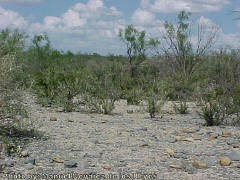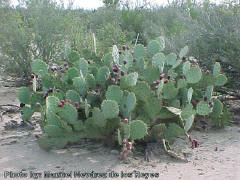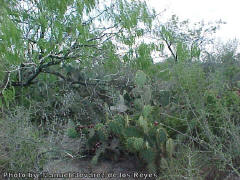|
 The
Matorral Tamaulipeco is an
arid
ecoregion dominated by
xerophytic shrubs
that lies in the lower elevations of the eastern
Sierra Madre Oriental Mountains in north-eastern Mexico (northern Nuevo
León, Coahuila, Tamaulipas) and southern Texas. The landscape undulates
with mountains, hills, valleys, and vast plateaus. Where
precipitation levels are
below 100 cm per year. The
Matorral Tamaulipeco is an
arid
ecoregion dominated by
xerophytic shrubs
that lies in the lower elevations of the eastern
Sierra Madre Oriental Mountains in north-eastern Mexico (northern Nuevo
León, Coahuila, Tamaulipas) and southern Texas. The landscape undulates
with mountains, hills, valleys, and vast plateaus. Where
precipitation levels are
below 100 cm per year.
The Tamaulipan Matorral is rich in plant and animal
biodiversity. A high number of
endemic
cacti, and
succulents such as Agave
victoria-reginae and
Astrophytum caput-medusae, make it a priority area for the
conservation of species.
 The
vegetation represents a transition from the desert scrub of the drier
mezquital in the lowlands to the woodlands of the Sierras. The matorral
of this zone is full of shrubs and small trees that can survive here
with the benefit of more moisture from mountain storms. The
vegetation represents a transition from the desert scrub of the drier
mezquital in the lowlands to the woodlands of the Sierras. The matorral
of this zone is full of shrubs and small trees that can survive here
with the benefit of more moisture from mountain storms.
 The
desert shrublands are primarily
threatened by agriculture, goat, sheep, and cattle grazing, and the
expansion of urban areas. The destruction of this vegetation type is
almost 90% in Texas and 70% in Mexico. Fires also destroy
habitat when used as a means to
convert the matorral to farms. Illegal extraction and trade of cacti
have helped make several species
endangered. The
desert shrublands are primarily
threatened by agriculture, goat, sheep, and cattle grazing, and the
expansion of urban areas. The destruction of this vegetation type is
almost 90% in Texas and 70% in Mexico. Fires also destroy
habitat when used as a means to
convert the matorral to farms. Illegal extraction and trade of cacti
have helped make several species
endangered.
"Photo kindly provided by Manuel Nevarez de los Reyes" |